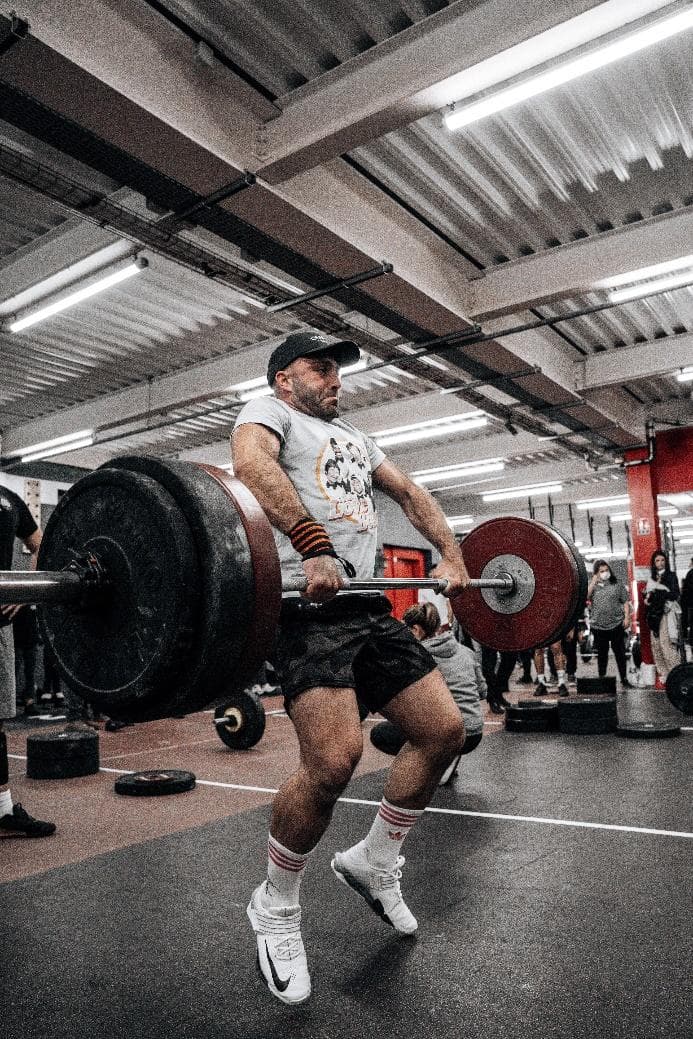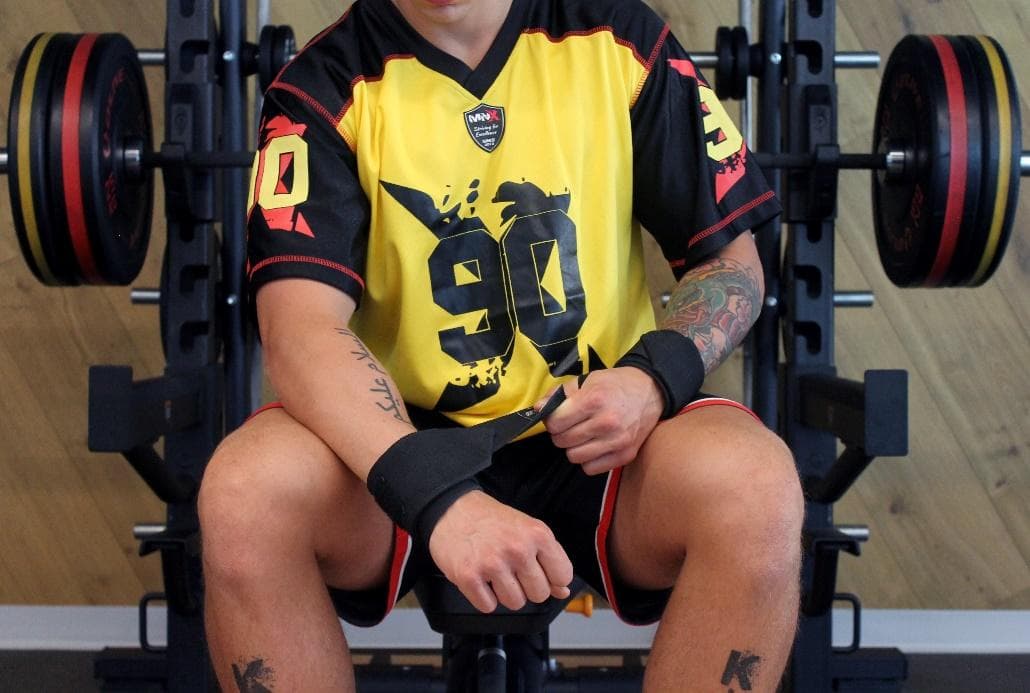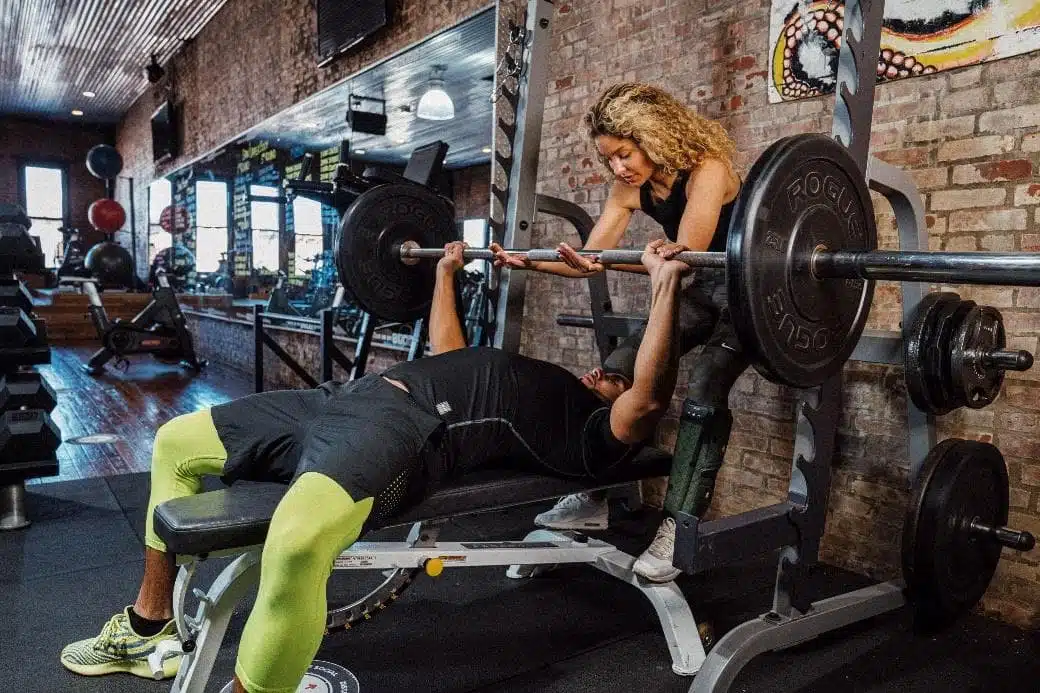2 de December de 2022
How To Measure Bar Velocity Step by Step
Reasons why it’s important to know how to measure bar velocity

The average velocity at which we move the bar can be used as a very good estimate of the relative load we are lifting. In 2010 this finding was first published in English (J. J. González-Badillo & Sánchez-Medina, 2010), but its origins go back to the pioneering work of González-Badillo in the 1980s and 1990s (Gónzález-Badillo, Sánchez-Medina, Pareja-Blanco, & Rodríguez-Rosell, 2017; González Badillo & Gorostiaga Ayestarán, 1995). The evidence that barbell velocity could be the best strategy to measure the real effort experienced by the athlete represented a breakthrough in the field of strength training, so much so that it has made the paradigm shift when monitoring load regulation (Juan José González-Badillo, Sánchez-Medina, Ribas-Serna, & Rodríguez-Rosell, 2022).
If we know how to measure the velocity of the barbell, we can regulate the training load much more accurately than had been the case without taking barbell velocity into account (Rodríguez-Rosell et al., 2018). In the last decade, technological options have been commercialized with which to know how to measure the velocity of the bar, taking advantage of the numerous investigations on velocity-based strength training or VBT for its acronym in English (Juan J. González-Badillo, Marques, & Sánchez-Medina, 2011; Juan José González-Badillo, Yañez-García, Mora-Custodio, & Rodríguez-Rosell, 2017; Pareja-Blanco, Rodríguez-Rosell, Sánchez-Medina, Gorostiaga, & González-Badillo, 2014; Pareja-Blanco et al., 2017).
Relative load
Once we know how to measure the velocity of the bar, we can determine the relative load we are using. Each percentage of our maximum repetition (%1RM) has its own average velocity (J. J. González-Badillo & Sánchez-Medina, 2010; Juan J. González-Badillo et al., 2011). If bar velocity is monitored with the right technology, this key information would be available in real time (Martínez-Cava et al., 2020). That means that when we perform a repetition against a load at the maximum velocity we can, we will immediately obtain the %1RM that that load supposes to us.
The velocity of the first repetition of the set is the one that is usually used as the fastest repetition. The faster the repetition, the lower the degree of effort, since the load lifted gives us a lower %1RM. Conversely, the same thing happens: the slower the first repetition, which is the fastest, the closer we will be to our 100% 1RM (J. J. González-Badillo & Sánchez-Medina, 2010; Juan J. González-Badillo et al., 2011).
Loss of velocity
Another advantage after knowing how to measure the velocity of the bar is that we can observe the loss of that velocity as we do repetitions in the series. The first repetition will be the fastest, but from there the velocity will decrease in the second, third, etc., causing the bar to move slower and slower. This event makes the loss of velocity in the series a very accurate indicator of the degree of effort or fatigue that the set of repetitions performed is giving us (Juan José González-Badillo et al., 2017; Guez-Rosell, Yanez-GarciA, Sanchez-Medina, Mora-Custodio, & Lez-Badillo, 2020)
Effort index
Knowing the velocity of the first repetition of the set, or the fastest repetition, and the velocity loss in each set, we can obtain the effort index (Rodríguez-Rosel l et al., 2018). This novel index has a close relationship with several physiological and mechanical markers of fatigue, so that the load can be adjusted extremely precisely (Sánchez-Medina & González-Badillo, 2011). That’s another main reason to learn how to measure bar velocity.
Training effectiveness
The last of the four reasons why it is necessary to control how to measure bar velocity is because we will be able to know if we are making progress or not. If we move a given load at a higher average velocity than in previous sessions, it means that the load has moved to a lower %1RM. Therefore, the maximum force applied to that load and the value of our 1RM has improved (Juan José González-Badillo et al., 2022).
How to measure bar velocity step by step for free if you don’t have a velocity measuring device

Bar velocity can be estimated directly with a velocity measuring device, or indirectly with some mobile apps. Vitruve has a free application that allows you to indirectly estimate bar velocity, an interesting measurement for all the reasons described in the previous section. Let’s see how to measure bar velocity step by step with the free Vitruve app. You can see in this video a case study where we explain how to measure bar velocity with the free VBT CAM application.
Download the free Vitruve VBT CAM app
The first step to measuring bar velocity is to download the Vitruve app for Android (at this link) or for iOS (at this link). Once downloaded, create an account with your email and password, verify it by clicking on the confirmation link that will arrive to your email, and you can start using it. To do so, simply fill in your details and click on the “start” box. From there you must select the exercise you are going to perform: clean, pull-ups, hip thrust, deadlift…
Record execution from Vitruve VBT CAM application
Put your cell phone in a place where you can clearly see the movement you are performing. If a person records the movement, they should record the exercise in the same way so that you can clearly see when the concentric phase begins and ends. Positioning the mobile or the person in profile is the best option to be able to determine later when the change between the eccentric phase and the concentric phase occurs. The execution of the movement must be performed at the maximum intentional or voluntary velocity (Juan José González-Badillo et al., 2017; Sánchez-Medina, Pallarés, Pérez, Morán-Navarro, & González-Badillo, 2017). This condition is key when it comes to knowing how to measure barbell velocity correctly.
Analyze movement in the app
Once the exercise is recorded, we must indicate to the application when the concentric or pushing phase begins and when it ends. It is important to be accurate in this measurement as it directly affects how to measure the velocity of the bar. Mark the exact frame of the video in which the concentric phase begins, and do the same with the final frame where the concentric phase ends.
We have already determined the time it took us to perform the repetition, now we need the distance to obtain the velocity of the bar. To calculate this distance, we have to determine the range of motion, i.e., the space that the bar has moved between the highest point and the lowest point. This process must be done manually, but if we always execute the same technique, it will be useful to calculate it only once per movement. Of course, there are some exercises such as the bench press that have less variability than others such as the squat.
In the bench press, our stretched arms have a stop at the top, and our chest has a stop at the bottom, which means that, unless we change the lumbar arch a lot, the distance does not vary. However, in the squat it can happen that we descend a little more or less, which affects the distance we have completed, and also the velocity. If we have already obtained that range of motion, we add it to the application and it will give us the speed at which we have moved the bar in that repetition.
Train based on the velocity you have obtained.
As each bar velocity is associated with a %1RM you can train based on it. You will simply have to record each movement and then analyze it in the app. The main advantage of Vitruve’s VBT CAM app is that it is free. The main drawback is that it is time consuming and does not give you real time information, but we get the bar velocity when we finish the movement and analyze it. A velocity measuring device does give immediate feedback. In addition, the device itself does all the calculations without the need to record or analyze video.
How to measure bar velocity with a velocity measuring device

The velocity measuring device must be valid and reliable
The first step, before knowing how to measure the velocity of the bar with a technological device, is that the device measures what we want to measure with minimal error. There are numerous bar velocity measuring devices on the market. Linear encoders have been shown to be the most valid and reliable (Martínez-Cava et al., 2020; Weakley, Morrison, et al., 2021), a group that includes the Vitruve device (Callaghan, Guy, Elsworthy, & Kean, 2022; Pérez-Castilla, Piepoli, Delgado-García, Garrido-Blanca, & García-Ramos, 2019). They are only outperformed by 3D optoelectronic 3D motion capture technology (Weakley, Mann, et al., 2021), but which has a significantly higher cost.
Hook the device to the bar and train
In this case, we don’t need to record ourselves, measure ranges of motion or analyze frames. We simply hook our device to the bar, and the linear encoder takes care of measuring the displacement of the load and the distance it has moved, therefore, we will know the velocity of the bar in each repetition. A fundamental aspect that we have already mentioned is that the movement must always be executed at the maximum intentional velocity for the result to be valid and reliable.
The main drawback of this option is that it is not free like Vitruve’s VBT CAM application, although its cost is significantly lower than that of 3D optoelectronic 3D motion capture technology. The main advantage of a linear encoder is that we get the velocity of the bar in real time and much more accurately. This allows us to know the velocity of the motion without the need for analysis, and also allows us to increase our motivation by showing it to us immediately (Weakley et al., 2020).
Joaquin Vico Plaza
References
Callaghan, D. E., Guy, J. H., Elsworthy, N., & Kean, C. (2022). Validity of the PUSH band 2.0 and Speed4lifts to measure velocity during upper and lower body free-weight resistance exercises. Journal of Sports Sciences, 40(9), 968–975. https://doi.org/10.1080/02640414.2022.2043629
González-Badillo, J. J., & Sánchez-Medina, L. (2010). Movement velocity as a measure of loading intensity in resistance training. International Journal of Sports Medicine, 31(5), 347–352. https://doi.org/10.1055/S-0030-1248333
Gónzález-Badillo, J. J., Sánchez-Medina, L., Pareja-Blanco, F., & Rodríguez-Rosell, D. (2017). Fundamentals of velocity-based resistance training, 205.
González-Badillo, Juan J., Marques, M. C., & Sánchez-Medina, L. (2011). The importance of movement velocity as a measure to control resistance training intensity. Journal of Human Kinetics, 29A(Special Issue), 15–19. https://doi.org/10.2478/V10078-011-0053-6
González-Badillo, Juan José, Sánchez-Medina, L., Ribas-Serna, J., & Rodríguez-Rosell, D. (2022). Toward a New Paradigm in Resistance Training by Means of Velocity Monitoring: A Critical and Challenging Narrative. Sports Medicine – Open 2022 8:1, 8(1), 1–24. https://doi.org/10.1186/S40798-022-00513-Z
González-Badillo, Juan José, Yañez-García, J. M., Mora-Custodio, R., & Rodríguez-Rosell, D. (2017). Velocity Loss as a Variable for Monitoring Resistance Exercise. International Journal of Sports Medicine, 38(3), 217–225. https://doi.org/10.1055/S-0042-120324
González Badillo, J. J., & Gorostiaga Ayestarán, E. (1995). Fundamentals of strength training. Sports Initiatives, 321.
Guez-Rosell, D. R., Yanez-GarciA, J. M., Sanchez-Medina, L., Mora-Custodio, R., & Lez-Badillo, J. J. G. (2020). Relationship Between Velocity Loss and Repetitions in Reserve in the Bench Press and Back Squat Exercises. Journal of Strength and Conditioning Research, 34(9), 2537–2547. https://doi.org/10.1519/JSC.0000000000002881
Martínez-Cava, A., Hernández-Belmonte, A., Courel-Ibáñez, J., Morán-Navarro, R., González-Badillo, J. J., & Pallarés, J. G. (2020). Reliability of technologies to measure the barbell velocity: Implications for monitoring resistance training. PLOS ONE, 15(6), e0232465. https://doi.org/10.1371/JOURNAL.PONE.0232465
Pareja-Blanco, F., Rodríguez-Rosell, D., Sánchez-Medina, L., Gorostiaga, E. M., & González-Badillo, J. J. (2014). Effect of movement velocity during resistance training on neuromuscular performance. International Journal of Sports Medicine, 35(11), 916–924. https://doi.org/10.1055/S-0033-1363985
Pareja-Blanco, F., Rodríguez-Rosell, D., Sánchez-Medina, L., Sanchis-Moysi, J., Dorado, C., Mora-Custodio, R., … González-Badillo, J. J. (2017). Effects of velocity loss during resistance training on athletic performance, strength gains and muscle adaptations. Scandinavian Journal of Medicine & Science in Sports, 27(7), 724–735. https://doi.org/10.1111/SMS.12678
Pérez-Castilla, A., Piepoli, A., Delgado-García, G., Garrido-Blanca, G., & García-Ramos, A. (2019). Reliability and Concurrent Validity of Seven Commercially Available Devices for the Assessment of Movement Velocity at Different Intensities During the Bench Press. Journal of Strength and Conditioning Research, 33(5), 1258–1265. https://doi.org/10.1519/JSC.0000000000003118
Rodríguez-Rosell, D., Yáñez-García, J. M., Torres-Torrelo, J., Mora-Custodio, R., Marques, M. C., & González-Badillo, J. J. (2018). Effort Index as a Novel Variable for Monitoring the Level of Effort During Resistance Exercises. Journal of Strength and Conditioning Research, 32(8), 2139–2153. https://doi.org/10.1519/JSC.0000000000002629
Sánchez-Medina, L., & González-Badillo, J. J. (2011). Velocity loss as an indicator of neuromuscular fatigue during resistance training. Medicine and Science in Sports and Exercise, 43(9), 1725–1734. https://doi.org/10.1249/MSS.0B013E318213F880
Sánchez-Medina, L., Pallarés, J., Pérez, C., Morán-Navarro, R., & González-Badillo, J. (2017). Estimation of Relative Load From Bar Velocity in the Full Back Squat Exercise. Sports Medicine International Open, 1(2), E80–E88. https://doi.org/10.1055/S-0043-102933
Weakley, J., Mann, B., Banyard, H., McLaren, S., Scott, T., & Garcia-Ramos, A. (2021). Velocity-based training: From theory to application. Strength and Conditioning Journal, 43(2), 31–49. https://doi.org/10.1519/SSC.0000000000000560
Weakley, J., Morrison, M., García-Ramos, A., Johnston, R., James, L., & Cole, M. H. (2021). The Validity and Reliability of Commercially Available Resistance Training Monitoring Devices: A Systematic Review. Sports Medicine, 51(3), 443–502. https://doi.org/10.1007/S40279-020-01382-W/TABLES/12
Weakley, J., Wilson, K., Till, K., Banyard, H., Dyson, J., Phibbs, P., … Jones, B. (2020). Show Me, Tell Me, Encourage Me: The Effect of Different Forms of Feedback on Resistance Training Performance. Journal of Strength and Conditioning Research, 34(11), 3157–3163. https://doi.org/10.1519/JSC.0000000000002887

